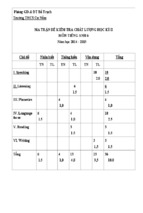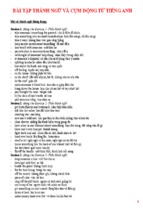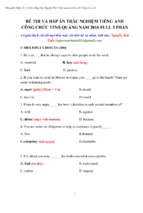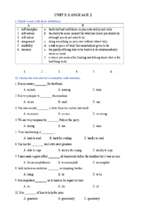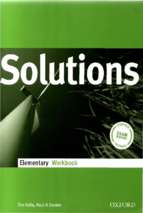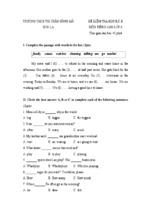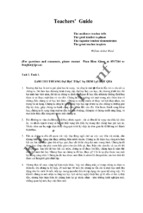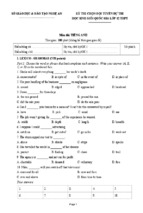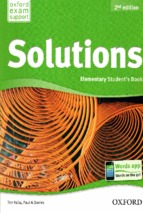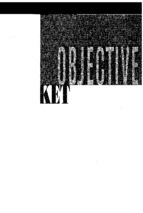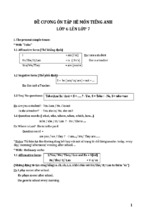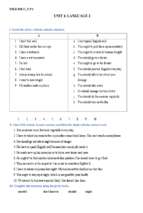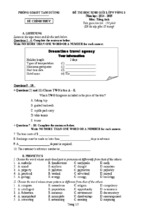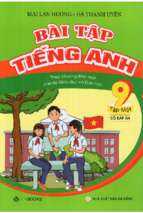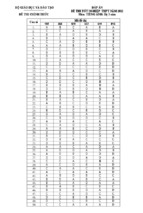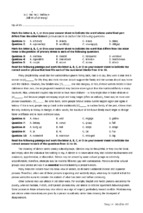HIGH-INTEREST
SKILLS & STRATEGIES
wledge
o
n
K
r
o
i
r
ions
t
c
e
r
i
P
D
e
w
t
abulary
o
c
l
o
a
l
V
v Fo
i
t
c
A
e
erences
f
f
i
c
D
S t o r y S e q u en
/
s
e
i
t
i
r
a
l
S i mi
LEVEL
3
100
REPRODUCIBLE ACTIVITIES
Reading Comprehension
Skills and Strategies
Level 3
Saddleback Educational Publishing
Three Watson
Irvine, CA 92618-2767
Web site: www.sdlback.com
Development and Production:
The EDGe
ISBN 1-56254-030-0
Copyright ©2002 by Saddleback Educational Publishing. All rights reserved. No part of this book may be reproduced in any
form or by any means, electronic or mechanical, including photocopying, recording, or by any information storage and
retrieval system, without written permission of the publisher, with the following exception.
Pages labeled Saddleback Educational Publishing ©2002 are intended for reproduction. Saddleback Educational
Publishing grants to individual purchasers of this book the right to make sufficient copies of reproducible pages for use by all
students of a single teacher. This permission is limited to an individual teacher, and does not apply to entire schools or
school systems.
Printed in the United States of America
06 05 04 03 02 9 8 7 6 5 4 3 2 1
Table of Contents
Skills
Teacher welcome and teaching tips . . . . . . . . . . . . . 4
Identifying familiar analogies . . . . . . . . . . . . . . . . . 33
Analyzing word structure—synonyms . . . . . . . . . . . . 6
Identifying familiar analogies . . . . . . . . . . . . . . . . . 34
Analyzing word structure—antonyms . . . . . . . . . . . . 7
Identifying unfamiliar analogies . . . . . . . . . . . . . . 35
Analyzing word structure—synonyms and
antonyms . . . . . . . . . . . . . . . . . . . . . . . . . . . . . . . . 8
Identifying unfamiliar analogies . . . . . . . . . . . . . . 36
Analyzing word structure—base words . . . . . . . . . . . 9
Interpreting a Venn diagram . . . . . . . . . . . . . . . . . . 38
Analyzing word structure—base words . . . . . . . . . . 10
Interpreting a Venn diagram . . . . . . . . . . . . . . . . . . 39
Analyzing word structure—word origins . . . . . . . . . 11
Interpreting idiom phrases . . . . . . . . . . . . . . . . . . . 40
Analyzing word structure—base words & prefixes . 12
Interpreting figures of speech . . . . . . . . . . . . . . . . . 41
Analyzing word structure—suffixes . . . . . . . . . . . . . 13
Recognizing the 5 W’s . . . . . . . . . . . . . . . . . . . . . . . 42
Analyzing word structure—suffixes . . . . . . . . . . . . . 14
Recognizing the 5 W’s . . . . . . . . . . . . . . . . . . . . . . . 43
Analyzing vocabulary using visual and
context clues . . . . . . . . . . . . . . . . . . . . . . . . . . . . . 15
Predictions of what will happen next . . . . . . . . . . . 44
Analyzing vocabulary using visual and
context clues . . . . . . . . . . . . . . . . . . . . . . . . . . . . . 16
Reading the table of contents . . . . . . . . . . . . . . . . . 46
Categorizing information . . . . . . . . . . . . . . . . . . . . 37
Predictions of what will happen next . . . . . . . . . . . 45
Using the index to preview content . . . . . . . . . . . . . 47
Analyzing vocabulary using visual and
context clues . . . . . . . . . . . . . . . . . . . . . . . . . . . . . 17
Using headings and captions to preview
and predict content . . . . . . . . . . . . . . . . . . . . . . . 48
Analyzing vocabulary using visual and
context clues . . . . . . . . . . . . . . . . . . . . . . . . . . . . . 18
Using headings and captions to preview
and predict content . . . . . . . . . . . . . . . . . . . . . . . 49
Analyzing vocabulary using visual and
context clues . . . . . . . . . . . . . . . . . . . . . . . . . . . . . 19
Analyzing vocabulary using context clues . . . . . . . 20
Making a movie in your mind to
preview and predict content . . . . . . . . . . . . . . . . . 50
Analyzing vocabulary—multiple-meaning
words . . . . . . . . . . . . . . . . . . . . . . . . . . . . . . . . . . . 21
Using illustrations and graphic devices to
predict content . . . . . . . . . . . . . . . . . . . . . . . . . . . 51
Analyzing vocabulary—multiple-meaning
words . . . . . . . . . . . . . . . . . . . . . . . . . . . . . . . . . . . 22
Reading the cover of a book to predict content . . . 52
Analyzing vocabulary—multiple-meaning
words . . . . . . . . . . . . . . . . . . . . . . . . . . . . . . . . . . . 23
Concentrating on the details of an ad
to make decisions . . . . . . . . . . . . . . . . . . . . . . . . . 54
Analyzing vocabulary—multiple-meaning
words . . . . . . . . . . . . . . . . . . . . . . . . . . . . . . . . . . . 24
Comparing reviews before making
a decision . . . . . . . . . . . . . . . . . . . . . . . . . . . . . . . 55
Analyzing vocabulary—signal words . . . . . . . . . . . 25
Comparing and contrasting details . . . . . . . . . . . . 56
Analyzing vocabulary—signal words . . . . . . . . . . . 26
Identifying topic and supporting sentences . . . . . . 57
Analyzing vocabulary—context clues in text . . . . . 27
Identifying problem/solution . . . . . . . . . . . . . . . . . . 58
Following directions . . . . . . . . . . . . . . . . . . . . . . . . . 28
Identifying supporting details . . . . . . . . . . . . . . . . . 59
Following directions . . . . . . . . . . . . . . . . . . . . . . . . . 29
Reading for details . . . . . . . . . . . . . . . . . . . . . . . . . . 60
Following directions using a graphic device . . . . . . 30
Interpreting a chart . . . . . . . . . . . . . . . . . . . . . . . . . 61
Identifying nouns in text . . . . . . . . . . . . . . . . . . . . . 31
Interpreting labels . . . . . . . . . . . . . . . . . . . . . . . . . . 62
Categorizing a list of items in text . . . . . . . . . . . . . 32
Interpreting labels . . . . . . . . . . . . . . . . . . . . . . . . . . 63
Reading the video case to predict content . . . . . . . 53
2
Interpreting a timeline/graphing
story events . . . . . . . . . . . . . . . . . . . . . . . . . . . . . . 64
Identifying the author’s view/purpose . . . . . . . . . 101
Identifying the author’s purpose . . . . . . . . . . . . . . 102
Interpreting an economic graphic device . . . . . . . . 65
Identifying the character’s view . . . . . . . . . . . . . . . 103
Interpreting a Venn diagram . . . . . . . . . . . . . . . . . . 66
Evaluating story events . . . . . . . . . . . . . . . . . . . . . 104
Developing a Venn diagram of your own . . . . . . . . 67
Sequencing events . . . . . . . . . . . . . . . . . . . . . . . . . 105
Interpreting a nutrition matrix . . . . . . . . . . . . . . . . 68
Critical thinking (own conclusions) . . . . . . . . . . . 106
Interpreting a superhero matrix . . . . . . . . . . . . . . . 69
Critical thinking (own conclusions) . . . . . . . . . . . 107
Distinguishing fact/opinion . . . . . . . . . . . . . . . . . . . 70
Critical thinking (own conclusions) . . . . . . . . . . . 108
Distinguishing fact/exaggeration . . . . . . . . . . . . . . 71
Critical thinking (own conclusions) . . . . . . . . . . . 109
Deleting trivial and redundant information . . . . . . 72
Identifying main character(s) . . . . . . . . . . . . . . . . 110
Deleting trivial and redundant information . . . . . . 73
Identifying setting . . . . . . . . . . . . . . . . . . . . . . . . . 111
Sequencing story events . . . . . . . . . . . . . . . . . . . . . . 74
Identifying setting . . . . . . . . . . . . . . . . . . . . . . . . . 112
Sequencing events . . . . . . . . . . . . . . . . . . . . . . . . . . 75
Identifying time . . . . . . . . . . . . . . . . . . . . . . . . . . . 113
Sequencing story events . . . . . . . . . . . . . . . . . . . . . . 76
Identifying time . . . . . . . . . . . . . . . . . . . . . . . . . . . 114
Sequencing story events . . . . . . . . . . . . . . . . . . . . . . 77
Identifying main idea . . . . . . . . . . . . . . . . . . . . . . 115
Sequencing using a timeline . . . . . . . . . . . . . . . . . . 78
Identifying main idea . . . . . . . . . . . . . . . . . . . . . . 116
Retelling a story . . . . . . . . . . . . . . . . . . . . . . . . . . . . 79
Identifying plot . . . . . . . . . . . . . . . . . . . . . . . . . . . . 117
Retelling a story . . . . . . . . . . . . . . . . . . . . . . . . . . . . 80
Planning a plot . . . . . . . . . . . . . . . . . . . . . . . . . . . 118
Identifying a topic sentence . . . . . . . . . . . . . . . . . . . 81
Predicting outcome . . . . . . . . . . . . . . . . . . . . . . . . 119
Identifying a topic sentence . . . . . . . . . . . . . . . . . . . 82
Predicting outcome . . . . . . . . . . . . . . . . . . . . . . . . 120
Identifying supporting sentences . . . . . . . . . . . . . . . 83
Making a generalization . . . . . . . . . . . . . . . . . . . . 121
Creating supporting details and facts . . . . . . . . . . . 84
Identifying tone/mood . . . . . . . . . . . . . . . . . . . . . . 122
Creating supporting sentences . . . . . . . . . . . . . . . . 85
Identifying tone/mood . . . . . . . . . . . . . . . . . . . . . . 123
Identifying supporting sentences . . . . . . . . . . . . . . . 86
Interpreting a graph . . . . . . . . . . . . . . . . . . . . . . . 124
Identifying cause and effect . . . . . . . . . . . . . . . . . . . 87
Interpreting a graph . . . . . . . . . . . . . . . . . . . . . . . 125
Identifying cause and effect . . . . . . . . . . . . . . . . . . . 88
Recalling factual details . . . . . . . . . . . . . . . . . . . . . 126
Identifying similarities and differences . . . . . . . . . . 89
Recalling factual details . . . . . . . . . . . . . . . . . . . . . 127
Identifying similarities and differences . . . . . . . . . . 90
Mapping story events . . . . . . . . . . . . . . . . . . . . . . . 128
Analyzing characters . . . . . . . . . . . . . . . . . . . . . . . . 91
Mapping story events . . . . . . . . . . . . . . . . . . . . . . . 129
Analyzing character attributes . . . . . . . . . . . . . . . . 92
Mapping story events . . . . . . . . . . . . . . . . . . . . . . . 130
Analyzing data . . . . . . . . . . . . . . . . . . . . . . . . . . . . . 93
Mapping story events . . . . . . . . . . . . . . . . . . . . . . . 131
Analyzing data . . . . . . . . . . . . . . . . . . . . . . . . . . . . . 94
Interpreting a timeline . . . . . . . . . . . . . . . . . . . . . . 132
Predicting outcomes . . . . . . . . . . . . . . . . . . . . . . . . . 95
Mapping story details . . . . . . . . . . . . . . . . . . . . . . 133
Predicting outcomes . . . . . . . . . . . . . . . . . . . . . . . . . 96
Mapping story details . . . . . . . . . . . . . . . . . . . . . . 134
Making inferences . . . . . . . . . . . . . . . . . . . . . . . . . . 97
Identifying author’s purpose . . . . . . . . . . . . . . . . . 135
Making inferences . . . . . . . . . . . . . . . . . . . . . . . . . . 98
Practicing good writing . . . . . . . . . . . . . . . . . . . . . 136
Making inferences . . . . . . . . . . . . . . . . . . . . . . . . . . 99
Teacher’s Scope and Sequence chart . . . . . . . . . . . 137
Identifying the author’s view/purpose . . . . . . . . . 100
Answer Key . . . . . . . . . . . . . . . . . . . . . . . . . . . . . . . 139
3
Teacher Pages just for you!
Welcome to Reading Comprehension
Skills and Strategies
About this Series
This unique series is specially created for you by Saddleback Educational Publishing,
as an exciting supplement to reinforce and extend your classroom reading curriculum.
Reading Comprehension Skills and Strategies can easily be integrated into basic reading
curricula as additional reading lessons: as stand-alone strategy and skill instructional
lessons; as across-the-curriculum lessons; or as activities for students with special
projects, interests, or abilities.
This series is based on the most current research and thought concerning the teaching
of reading comprehension. This series not only sharpens traditional reading
comprehension skills, but also reinforces the critical reading comprehension strategies
that encourage your students to use prior knowledge, experiences, careful thought,
and evaluation to help them decide how to practically apply what they know to all
reading situations.
Traditional comprehension skills recently have been woven into the larger context of
strategy instruction. Today, literacy instruction emphasizes learning strategies—those
approaches that coordinate the various reading and writing skills and prior knowledge
to make sense to the learner. Our goal in this series is to provide you and your
students with the most up-to-date reading comprehension support, while teaching
basic skills that can be tested and evaluated.
Reading Comprehension Strategies
•
•
•
•
•
•
•
•
vocabulary knowledge
activating prior knowledge
pre-reading—previewing and predicting
previewing and predicting text
mental imaging
self-questioning
summarizing
semantic mapping
Saddleback Educational Publishing promotes the development of the whole child with
particular emphasis on combining solid skill instruction with creativity and
imagination. This series gives your students a variety of opportunities to apply reading
comprehension strategies as they read, while reinforcing basic reading comprehension
skills. In addition, we designed this series to help you make an easy transition between
levels (grades 2, 3, and 4) in order to reinforce or enhance needed skill development for
individual students.
4
About this Book
Reading Comprehension Skills and Strategies is designed to reinforce and extend the
reading skills of your students. The fun, high-interest fiction and non-fiction
selections will spark the interest of even your most reluctant reader. The book offers
your students a variety of reading opportunities—reading for pleasure, reading to
gather information, and reading to perform a task. A character on each page
prompts the student to apply one of the strategies to the reading selection which is
linked to a relevant comprehension skill activity.
Choosing Instructional Approaches
You can use the pages in this book for independent reinforcement or extension,
whole group lessons, pairs, or small cooperative groups rotating through an
established reading learning center. You may choose to place the activities in a
center and reproduce the answer key for self-checking. To ensure the utmost
flexibility, the process for managing this is left entirely up to you because you
know what works best in your classroom.
Assessment
Assessment and evaluation of student understanding and ability is an ongoing
process. A variety of methods and strategies should be used to ensure that the
student is being assessed and evaluated in a fair and comprehensive manner.
Always keep in mind that the assessment should take into consideration the
opportunities the student had to learn the information and practice the skills
presented. The strategies for assessment are left for you to determine and are
dependent on your students and your particular instructional plan. You will find a
Scope and Sequence Chart at the back of this book to assist you as you develop
your assessment plan.
5
Synonyms are words that have the same or nearly
the same meaning. So, tap into what you know
(about words) and give it a go!
Directions:
Select a synonym for the underlined word in the sentences from the Word Bank.
Write the synonym on the line.
k
Word Ban
Father
neat
dashed
sick
talk
large
mistakes
over
put
small
1.
Dad is picking me up from school today.
2.
The twins keep their bedroom very clean.
3.
Maria ran across the road.
4.
The baby became ill at day care.
5.
Will you speak to my teacher?
6.
The picture hung above the fireplace.
7.
The huge bird landed on our deck.
8.
Please place the plate on the table.
9.
Four errors were marked on my test.
10.
Let’s order a little pan-size pizza.
Name: _______________________________________
Reading Comprehension • Saddleback Educational Publishing ©2002
6
Date:
_____________________
3 Watson, Irvine, CA 92618•Phone(888)SDL-BACK•www.sdlback.com
Hey, did you know that antonyms are words that
have opposite meanings? Use what you know about
opposites to complete this activity. Have fun!
Directions:
Read the rhymes. Something is wrong—they don’t rhyme. Change them
by writing the correct antonyms of the underlined words. Use the Word
Bank and then read the rhymes again.
Word Bank
head
play
moon
hum
wet
stay
around
night
quiet
sweet
1. I always choose toys I can cuddle in bed.
My favorite’s a bear with a bow on its foot.
2. A playful monkey took my hat one day.
I told him he could keep it if he’d go away and rest.
3. How would it be to dance on the sun?
I’d like to be first—can you think of a tune?
4. At day by the campfire, I sing my best songs.
If you don’t know the words you can just yell along.
5. If I could choose an animal to take home for a pet,
I would take a penguin, so loud and so dry.
6. While walking in the city and not looking at my feet,
I fell into a sewer where the smell was none too sour.
Name: _______________________________________
Reading Comprehension • Saddleback Educational Publishing ©2002
7
Date:
_____________________
3 Watson, Irvine, CA 92618•Phone(888)SDL-BACK•www.sdlback.com
Okay, so now you are an expert on synonyms and
antonyms. Use what you’ve learned below.
Directions: In each blank write the letter of the word that is a synonym or antonym of the
underlined word.
Antonyms
Synonyms
1. ____ Sue enjoyed the show.
a. liked
b. watched
c. disliked
1. ____ We climbed up narrow stairs.
a. wide
b. long
c. tall
2. ____ Give me a clue.
a. chance
b. prize
c. hint
2. ____ That is not true.
a. crazy
b. false
c. sad
3. ____ Open the door.
a. lock
b. close
c. unlock
3. ____ Ted will arrive later.
a. today
b. sooner
c. nearer
4. ____ Imagine you are a rock star.
a. forget
b. pretend
c. believe
4. ____ Nothing seems to fit.
a. Something
b. Everything
c. Anything
5. ____ My teacher sent the note.
a. envelope
b. letter
c. picture
5. ____ The ice felt smooth.
a. slick
b. wet
c. rough
Name: _______________________________________
Reading Comprehension • Saddleback Educational Publishing ©2002
8
Date:
_____________________
3 Watson, Irvine, CA 92618•Phone(888)SDL-BACK•www.sdlback.com
Always remember to ask yourself: What is the
base word? If you do that you will not have any
problems with the activity below.
Directions:
A base word is a word from which other words are made. Write the base
of each word on the line.
Example:
short
shortest ____________
1. teacher
11. flowers
21. friendly
2. helpful
12. branches
22. foolish
3. clues
13. braver
23. repay
4. artist
14. numbers
24. owner
5. arrived
15. unkind
25. lowest
6. laughed
16. missed
26. replace
7. building
17. trees
27. tables
8. longest
18. smaller
28. started
9. asks
19. voices
29. shorter
20. churches
30. sleepy
10. farmer
Name: _______________________________________
Reading Comprehension • Saddleback Educational Publishing ©2002
9
Date:
_____________________
3 Watson, Irvine, CA 92618•Phone(888)SDL-BACK•www.sdlback.com
Always be on the lookout for base words.
Directions:
Read the story carefully. Then find the bold words and underline the base word
for each. Finally, answer the questions.
Zebras are among the most beautiful animals on earth. With their bold
black-and-white stripes, they stand apart from other African animals. They
roam freely over the large African plains. Many people don’t know it, but
the zebra is one of the few wild horses left in the world today. All horses
belong to the same animal group, known as Equus.
Zebras are shorter than most other horses,
their ears are larger, and some of them make
a barking sound! Most importantly, only
zebras have stripes—even their manes are
striped! Many zebras have been killed for their
beautiful skins. Fortunately, things are being
done to protect zebras now. African governments and
wildlife groups have set up nature preserves, where
zebras can live without the risk of being hunted.
1. Where do all the world’s wild zebras live? _________________________________
______________________________________________________________________
2. What is the animal group to which zebras belong? ________________________
______________________________________________________________________
3. List three things you learned about zebras by reading the selection. __________
______________________________________________________________________
______________________________________________________________________
4. How are people trying to help protect zebras? ____________________________
______________________________________________________________________
______________________________________________________________________
Name: _______________________________________
Reading Comprehension • Saddleback Educational Publishing ©2002
10
Date:
_____________________
3 Watson, Irvine, CA 92618•Phone(888)SDL-BACK•www.sdlback.com
It’s really cool to learn about where words in the
English language came from. Have fun exploring!
Directions:
Write words from the lunch box to replace words in the story that are
from Old English and other languages in ( ). Use each word only once.
clock
seat
milk
books
school
yell
right
twisting
take
melted
brushing
out
Marina was dozing in and (ut) __________ of sleep when she heard her Dad
(giellan) ____________, “Get up, now! You’re late for (skole) _______________.”
“Late?” shrieked Marina. He was (riht) _______________. As she leapt out of bed,
she glanced at the (clocca) ______________. She had just eight minutes until the
bus arrived. She quickly dressed, throwing on a T-shirt and sneakers. After
(twisten) ________________ her hair into a quick knot and (broose)
________________ her teeth, she tore downstairs and headed toward the door.
Dad handed her (boc) ________________ to her. He looked sorry. “We’re out of
cereal. Get some (milc) ________________ when you get to school,” he suggested.
The bus pulled up and Marina sprinted over and hopped on. The only (saeti)
____________ left was next to Jarvis, who always smelled a bit like fried bacon.
“Yuck,” she thought. As she sat down, she felt something weird and wriggled
around a bit. “Oh, no!” she cried to herself as she (meltan) ______________ into
the seat. She had forgotten to (taka) ______________ off her pajama bottoms. It
was going to be one of those days.
Name: _______________________________________
Reading Comprehension • Saddleback Educational Publishing ©2002
11
Date:
_____________________
3 Watson, Irvine, CA 92618•Phone(888)SDL-BACK•www.sdlback.com
You, yes you, can unlock the meaning of hundreds
of words by knowing the meaning of base words
and prefixes.
Directions:
The prefix un means “not.” Read the story, then add the un prefix to the underlined
words to change the meaning of the story. Finally, read the story again.
It sounds amazing and a bit ____real, but this tale has been passed down from
a very long time ago. I am ____certain where it came from, but it does not
make me ____happy to tell it again to you. So here goes.
In a land far away there was an ____happy, ____grateful, and altogether cranky
troll named Rolf. He hated just about everything! He thought all rules were
____necessary and that school was boring. He thought all the other troll
children and even his teacher were ____friendly. He even hated recess! One day
at recess the troll children were picking teams for
kickball. They had an ____equal number of
players on each team. Of course, the only troll
not on a team was Rolf. So the troll children
____easily asked ____kind and ____predictable
Rolf to join their team. Well, the rest, as they
say, is history. That day Rolf brought in the
winning run for his team. Rolf changed from
an ____lucky and ____loved little troll into a
happy and friendly troll.
Name: _______________________________________
Reading Comprehension • Saddleback Educational Publishing ©2002
12
Date:
_____________________
3 Watson, Irvine, CA 92618•Phone(888)SDL-BACK•www.sdlback.com
Do you know that suffixes are groups of letters
added to the end of words and they can change
the meaning of the word?
Directions:
Read the first sentence in each set. It gives you the base word. In the second and
third sentences add the suffixes from the Suffix Box to create new meanings for
the base words.
ly
ness ities
Suffix Box
en est ery
ing
ition
You may use these more than one time.
A.
1. The boy is quiet.
2. The boy sits quiet_______.
3. The quiet________ was not disturbed.
B.
1. My grandpa is active and does many things.
2. Grandpa has many fun activ_______ that he enjoys, like golf.
3. He always active_______ tries new things.
C.
1. I have a new light in my bedroom.
2. The yellow paint on the walls of my room really help light_______ it up.
3. I put my favorite teddy bear light_______ on my pillows.
D.
1. The knight was very brave.
2. He was the brav_______ in the castle.
3. He even got a medal for brav_______.
E.
1. Math is my favorite subject. I love to add and subtract.
2. You’ll find me add_______ up things all the time.
3. My teacher thinks I’m a great add_______ to her classroom.
Name: _______________________________________
Reading Comprehension • Saddleback Educational Publishing ©2002
13
Date:
_____________________
3 Watson, Irvine, CA 92618•Phone(888)SDL-BACK•www.sdlback.com
Use what you already know about base words and
suffixes to create new words below.
Directions:
Add the suffix ly, er, or ing to a base word on the towel to complete each
sentence. Remember, if a word ends in e, take off the e before adding ing.
bad
cold
clean
quick
drink
high
flake
shower
short
wear
itch
bath
use
1. In ________________ months, our skin dries out more _________________.
2. ___________________ and __________________ are common problems.
3. In the winter, __________________ your skin gently is important.
4. ____________________ is important, but not more than once a day.
5. After ____________________ just pat your skin dry. Don’t rub it dry.
6. Take ____________________ bath or showers.
7. Avoid ___________________ itchy fabrics next to your skin.
8. _____________________ lots of water will help.
9. ______________________ lotion helps also.
10. Keep the heat in your house no ____________________
than 70 degrees.
11. Go to the doctor if your skin starts
itching ______________________.
Name: _______________________________________
Reading Comprehension • Saddleback Educational Publishing ©2002
14
Date:
_____________________
3 Watson, Irvine, CA 92618•Phone(888)SDL-BACK•www.sdlback.com
Make a movie in your mind. Picture beautiful
Puerto Rico as you read the selections below.
Bon Voyage!
Directions:
Use the pictures and the words in each selection to answer the questions below.
¡Hola Puerto Rico! Bordered by the Atlantic Ocean and the
Caribbean Sea, Puerto Rico, with its rich Hispanic heritage,
is America’s premier 100-mile-long island territory. The
Puerto Ricans are self-governed U.S. citizens.
Hey! Try this trick to remember the name of the capital of Puerto
Rico. Imagine you are walking along a sandy beach and you find
a magic wand. You pick up the wand and wave it over the sand
and NOTHING! So much for sand and wands! Well, use this
“picture” to remember that San Juan is the capital of Puerto Rico.
Did you know that treasure ships once sailed the water near
Puerto Rico? Their hulls were filled with gold as they headed
for Spain. Some of them sank in storms off the coast of Puerto
Rico. They are still there, somewhere, and treasure hunters are
on the lookout.
The skies over Puerto Rico can send down buckets of rain,
and then be clear and completely dry 15 minutes later. In
Puerto Rico’s El Yunque rainforest, you can see a storm on
one mountain and clear skies over a nearby mountain.
1. What two large bodies of water border Puerto Rico? _________________________
________________________________________________________________________
2. What is the capital of Puerto Rico? _________________________________________
3. Where were the treasure ships that sailed from the Caribbean headed? _________
________________________________________________________________________
4. What is the weather like in Puerto Rico? ____________________________________
5. Is Puerto Rico a state, a country, or a territory island of the U.S.? ______________
________________________________________________________________________
6. What is the heritage of the Puerto Rican people? ____________________________
Name: _______________________________________
Reading Comprehension • Saddleback Educational Publishing ©2002
15
Date:
_____________________
3 Watson, Irvine, CA 92618•Phone(888)SDL-BACK•www.sdlback.com
Hey, did you know that you can use pictures and
captions to figure out new words in a selection before
you read?
Directions:
Look at the picture, read the caption, and read the selection.
Then answer the questions below.
Bones
Skull
Collarbone
Shoulder
blade
Ribs
Humerus
Elbow
joint
Pelvic
girdle
You have 206 bones in your body. Both boys and
girls have the same number of bones. They
make up the framework, or skeleton, that
supports the tissues and muscles. Your bones are
important because of the structure they provide
and also because of what they contain. Together
they give your body shape, and—moved by your
muscles—help you to run after a ball, take a
walk, or type a letter to your mom. They protect
delicate body parts. They also store bone marrow
to produce blood cells and contain important
minerals like calcium and phosphorus that can
be released into your blood.
1. Where can you find the humerus bone?
___________________________________________
Femur
Knee joint
Kneecap
(patella)
2. What is the longest bone in your body and
where is it located?
___________________________________________
3. Your kneecap has a special name. What is it?
___________________________________________
Tibia
4. Your skeleton is the framework of your body.
What does framework mean?
___________________________________________
5. Bones also give you calcium and phosphorus.
These are a few of the bones in the
body. The femur is the longest bone.
Can you find it on your body?
What are those things?
___________________________________________
Name: _______________________________________
Reading Comprehension • Saddleback Educational Publishing ©2002
16
Date:
_____________________
3 Watson, Irvine, CA 92618•Phone(888)SDL-BACK•www.sdlback.com
Use what you know and ask yourself questions
as you figure out this article.
Directions:
Read the paragraph without stopping to figure out the missing words. Now read
it again and write the number of the missing word in the blank. Watch out!
There are three extra words you won’t need.
1.
2.
3.
4.
5.
6. over
7. five
8. need
9. players
10. love
middle
point
game
played
by
11.
12.
13.
14.
15.
out
in
hit
winner
gym
If you like tennis, then you’ll _____ badminton. This _____ was named after an
English duke’s estate where the game was first _____. To play badminton, you
_____ a net, a lightweight racket, and a small ball with feathers, sometimes called
a “birdie.” The game is played _____ two to four players, either indoors or
outdoors on a marked-out area, or court. The net is stretched across the _____ of
the court to a height of _____ feet. The players _____ the birdie back and forth
over the net with the rackets. A _____ is scored when the side that served the
birdie causes the receiving side to miss sending it back _____ the net. A game is
usually played to 15 points. A badminton match consists of winning two _____ of
three games. Badminton became an official Olympic sport at the 1992
Olympic Games _____ Barcelona, Spain.
Not so fast, sports fan! Read it one more
time to be sure your answers make sense.
Name: _______________________________________
Reading Comprehension • Saddleback Educational Publishing ©2002
17
Date:
_____________________
3 Watson, Irvine, CA 92618•Phone(888)SDL-BACK•www.sdlback.com
Check out the pictures, names, and the words
in the clues.
Directions:
Read each paragraph and answer the questions.
1. You can find me in the forest and swamps of South America.
Three large powerful claws on each front foot make it easy to
rip apart nests of termites and ants.
My two-foot long snake-like tongue is coated with gummy
saliva so that ants and termites will stick to it. Mmm, yummy!
tarantula
What am I?___________________________________________
2. My home is a burrow in the soil.
I love to eat small frogs, toads, and mice, mainly at night.
I am dark-colored with a hairy body and legs.
mountain lion
What am I?___________________________________________
3. I live alone and eat only meat.
My strong, muscular legs help me leap distances of more
than 20 feet.
Some of my many names are: puma, cougar, and panther.
What am I?___________________________________________
coyote
4. I hunt at night and store what I kill in the branches of a tree.
Lions, tigers, and jaguars belong to the same animal
family as I do.
I am known for my unusual spotted coat.
What am I?___________________________________________
anteater
5. I am a mammal that is known for speed and for being smart.
Both your family’s pet dog and wolves in the wild are
relatives of mine.
My nightly howls and short yaps break up the silence
of nighttime.
What am I?___________________________________________
Name: _______________________________________
Reading Comprehension • Saddleback Educational Publishing ©2002
18
Date:
leopard
_____________________
3 Watson, Irvine, CA 92618•Phone(888)SDL-BACK•www.sdlback.com
Flash! Watch out for a comma (,) or a dash (—).
They can be signals that tell you the meaning
of an unfamiliar word that is coming up.
Directions:
Read the sentences and then write the meaning of the word.
Moving West
During the 1800s, people called “pioneers” moved
west to start a new life. At that time, most of the
western lands were still territories—U. S. lands that
were not yet states.
1. Territories means _______________________________________________________
Some pioneers moved west so they could claim land. If they lived on a piece
of land for a few years they could get title, or ownership, to that land.
2. Title means ____________________________________________________________
Pioneers used oxen, horses, and mules to pull their covered wagons. Mules
were strong and moved fast. The trouble with mules was that sometimes
they stampeded, or ran off in panic, and left their owners stranded.
3. Stampeded means ______________________________________________________
Pioneers traveled in groups called “wagon trains”. Each wagon train had a
captain. The captain decided who would be the outriders—men who kept
an eye out for trouble. The captain also decided where the wagon train
stopped to camp at night.
4. Outriders means _______________________________________________________
Thousands of heavy wagons traveled the trails west year after year. The
wagons carved ruts, or deep grooves, into the trails. In some parts of the
western U. S. today, those ruts are still faintly visible on the land.
5. Ruts means ____________________________________________________________
Name: _______________________________________
Reading Comprehension • Saddleback Educational Publishing ©2002
19
Date:
_____________________
3 Watson, Irvine, CA 92618•Phone(888)SDL-BACK•www.sdlback.com
- Xem thêm -

